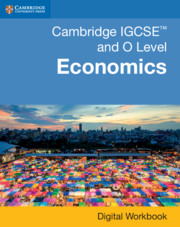This series helps students understand economic theory, terminology and principles. It matches the Cambridge IGCSE and O Level Economics syllabuses. The coursebook helps students apply tools of economic analysis, make judgements on economic issues, use basic economic numeracy and literacy, and take greater part in decision-making processes in everyday life. Sample questions provide opportunities for students to develop their evaluative skills. It provides a foundation for advanced study in Economics such as A Level. Answers to the coursebook and workbook questions are in the teacher's resource.
Features
- Introduces topics and presents economic concepts in the context of the learner, making Economics relevant to everyday life.
- Equips students with an understanding of the language of Economics and supports the development of their evaluative skills with essay questions.
- Key terms highlight and explain important concepts, helping students produce clear and accurate answers.
- A range of new practice exercises builds students' Economics skills and confidence with the subject.
- Provides the most comprehensive support for students.
- Group activities encourage peer support and provide opportunities for students to express themselves.
- The series also includes a workbook, revision guide, teacher's resource and Elevate enhanced edition.
- Endorsed by Cambridge International Examinations, Cambridge IGCSE and O Level Economics covers the Cambridge IGCSE syllabus (0455) and the Cambridge O Level syllabus (2281), first assessment 2020.
Table of Contents
- Introduction
- Section 1. The basic economic problem
- Chapter 1. The nature of the economic problem
- Chapter 2. Factors of production
- Chapter 3. Opportunity cost
- Chapter 4. Production possibility curves
- Examination practice
- Section 2. The allocation of resources
- Chapter 5. Microeconomics and macroeconomics
- Chapter 6. The role of markets in allocating resources
- Chapter 7. Demand
- Chapter 8. Supply
- Chapter 9. Price determination
- Chapter 10. Causes of price changes
- Chapter 11. Price elasticity of demand
- Chapter 12. Price elasticity of supply
- Chapter 13. Market economic system
- Chapter 14. Market failure
- Chapter 15. Mixed economic system
- Examination practice
- Section 3. Microeconomic decision makers
- Chapter 16. Money and banking
- Chapter 17. Households
- Chapter 18. Workers
- Chapter 19. Trade unions
- Chapter 20. Firms
- Chapter 21. Firms and production
- Chapter 22. Firms? costs, revenue and objectives
- Chapter 23. Market structure
- Examination practice
- Section 4. Government and the macroeconomy
- Chapter 24. The role of government
- Chapter 25. The macroeconomic aims of government
- Chapter 26. Fiscal policy
- Chapter 27. Monetary policy
- Chapter 28. Supply-side policy
- Chapter 29. Economic growth
- Chapter 30. Employment and unemployment
- Chapter 31. Inflation and deflation
- Examination practice
- Section 5. Economic development
- Chapter 32. Living standards
- Chapter 33. Poverty
- Chapter 34. Population
- Chapter 35. Differences in economic development between countries
- Examination practice
- Section 6. International trade and globalisation
- Chapter 36. International specialisation
- Chapter 37. Free trade and protection
- Chapter 38. Foreign exchange rates
- Chapter 39. Current account of the balance of payments
- Examination practice
- Index.
Advice on useful tools
Advice on useful tools, activities and timetabling from teachers experiencing school closures.
Cambridge GO
All our supporting resources have now moved to Cambridge GO – the new home for your Cambridge digital content.
Listen to our podcast
Listen to our podcast to discover teaching inspiration & advice from leading educational thinkers.








